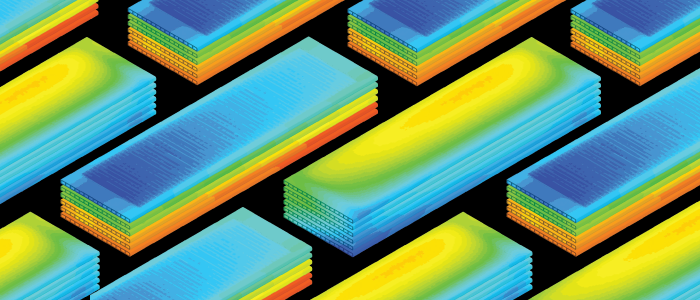Above: LG Fuel Cell Systems Inc. has developed a multi-physics code for performance calculations of its solid-oxide fuel cell structures. The code is based upon an enhanced computational fluid dynamics software package that allows for coupled simulations of the fluid flow, porous flow, heat transfer, chemical, electrochemical and current flow processes that occur in solid-oxide fuel cells.
High-temperature, solid-oxide fuel cells (SOFCs) are efficient electrochemical devices that produce electrical power from hydrocarbon fuels. SOFCs have received increasing attention in recent years as a clean and efficient power source for use in distributed power-generation applications.
LG Fuel Cell Systems Inc. (LGFCS) is developing a megawatt-scale hybrid SOFC stationary power-generation system based upon its patented design.
To support product design and development activities, LGFCS has developed a SOFC multi-physics code (MPC) for performance calculations of its fuel cell structure. The MPC is based upon a computational fluid dynamics (CFD) software package, which has been enhanced with new models that allow for coupled simulations of the fluid flow, porous flow, heat transfer, chemical, electrochemical and current flow processes that occur in SOFCs. Simulations of single-cell, five-cell, substrate and multi-cell models have been validated successfully against LGFCS’ experimental data. The MPC provides invaluable performance information, which drives design improvements, as well as enhancement in the fuel cell components, substrates, multi-cells and peripheral stack components.
“LGFCS has been running the larger MPC models on Ohio Supercomputer Center systems. Typically, these MPC models are between one- and ten-million grid cells in size and are run in parallel using between 12 and 96 cores,” said Carlos Martinez Baca, Ph.D., a CFD engineer with LGFCS. “A wide range of simulations have been run, from highly detailed models of electrochemistry and SOFC design to models of the peripheral components inside the LGFCS system.”
To date, one of the most involved models is of a multi-cell simulation, which consists of a collection of six ceramic substrates with a printed cell pattern that includes hundreds of interconnected cells. Each of these interconnected cells comprises two porous electrodes (an anode on the fuel side and a cathode on the air side) that are separated by a gas-tight solid-oxide electrolyte layer. This multi-cell simulation also contains two main flow streams, a fuel-gas mixture rich in hydrogen flowing inside the substrates and a separate air stream flowing over the outside. The fuel-gas mixture diffuses through the porous substrate from the internal flows, and oxygen is supplied from the outside air stream.
Electrochemical and chemical reactions occur in each cell and generate electrical power and heat.
Multi-cell simulations run at OSC have been used for a variety of purposes, including verifying on-design operation, analyzing off-design transients and performing analysis of new designs and operating modes.
Project Leads: Carlos Martinez Baca and Ben Haberman, LG Fuel Cell Systems Inc.
Research Title: High temperature solid oxide fuel cell development in Ohio
Funding Source: Department of Energy
Website: http://www.rolls-royce.com/energy/energy_products/fuel_cells/

